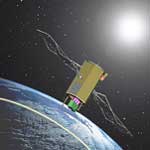Pathfinder Missions to Enhance Our Understanding of Earth
by NASA Jet Propulsion Lab
More articles in SatellitesAs part of the Earth System Science Pathfinder small-satellite program, NASA has selected two new space mission proposals that will yield fresh insight into our home planet’s carbon cycle and how oceans affect and respond to climate change -- knowledge that will help better life here on Earth. Both missions will be managed by NASA’s Jet Propulsion Laboratory, Pasadena, Calif.
 Artist's concept of Orbiting Carbon Observatory
Artist's concept of Orbiting Carbon ObservatoryPartnering with NASA centers, universities, industry and international participants, the Orbiting Carbon Observatory and the Aquarius missions will enhance NASA’s mission: to better understand and protect our home planet.
"The Orbiting Carbon Observatory will provide global measurements of atmospheric carbon dioxide needed to describe the geographic distribution and variability of carbon dioxide sources and sinks," said Dr. Ghassem Asrar, associate administrator for Earth Science, NASA Headquarters, Washington, D.C.
"Aquarius will provide the first-ever global maps of salt concentration on the ocean surface, a key area of scientific uncertainty in the oceans' capacity to store and transport heat, which in turn affects Earth’s climate and the water cycle," Asrar said.
The Orbiting Carbon Observatory, a mission that partners with industry and academia, will generate knowledge needed to improve projections of future carbon dioxide levels within Earth’s atmosphere. Increasing carbon dioxide (CO2) concentrations have raised concerns about global warming. Even though the biosphere and oceans are currently absorbing about half of the CO2 generated by human activities, the nature and geographic distribution of these CO2 sinks are too poorly understood to predict their response to future climate and land-use changes.
Dr. David Crisp of JPL will be the principal investigator for the mission. It will include more than 19 universities and corporate and international partners.
Aquarius will provide global maps of ocean-salt concentration on a monthly basis over its planned three-year mission life. By gaining these global, monthly maps researchers can better understand the nature of Earth’s oceans and their role in storage and distribution of heat and thus their role in global climate change.
Aquarius will measure variations in salinity to determine how the ocean responds to the combined effects of evaporation and precipitation, ice melt and river runoff on seasonal and interannual time scales. This is critical information to understand how salinity variations modify ocean circulation and the global redistribution of heat.
Dr. Chet Koblinsky of NASA's Goddard Space Flight Center, Greenbelt, Md., will serve as principal investigator for the Aquarius mission. Aquarius also will partner with the Argentine Space Program, building on a successful long-standing relationship between NASA and Argentina. In all, over 17 universities and corporate and international partners will be involved in the Aquarius mission.
"We are extremely excited about participating in these breakthrough missions,” said Dr. Diane Evans, director for the Earth Science and Technology Directorate at JPL. “Each performs a first-of-a-kind exploratory measurement that will help answer fundamental questions about how our planet is changing and how it will change in the future.”
In addition to the two selected new missions, a third proposal from JPL, called Hydros, has been selected to serve as an alternate to the selected missions, should the primary missions encounter difficulties during the initial development phases. The Hydros mission concept calls for a spacecraft that would monitor soil moisture from space -- a measurement that would improve current models for weather and climate predictions.
NASA will fund up to $175 million for each of the two selected missions. The selected missions will have approximately nine months to refine their proposals to mitigate risk before mission development is fully underway.
NASA issued an Announcement of Opportunity and initially received 18 proposals, six of which were selected for detailed assessment, with two now moving on toward final implementation.
NASA conducts Earth science research to better understand and protect our home planet. Through the examination of Earth, we are developing the technologies and scientific knowledge needed to explore the universe while bettering life on our home planet.